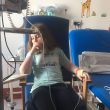Justifying and addressing the audience
One of the main reasons that led me to research this topic was the growing number of suicides among young people with autism. It’s worrying to have people in your own family, group of friends, co-workers and classmates, for example, who may be struggle with suicidal thoughts and doesn’t know how to seek help or talk about it. Our lack of knowledge about the conditions of a person with autism and the taboos related to suicide, which often prevent us from talking about the subject, aggravates the situation and makes us accomplices neglecting them.
Talking about suicide among autistic people, whether they are children, young people or adults, is important because it is directly related to the mental health of the general population. If one in 100 people in the UK are autistic, at least two more people in this same 100 will be affected by the struggles and distresses associated with this condition. So the intended primary audience for this story is all people who are autistic or who fall on some of the autism-related spectrums. In addition to them, all people who in some way participate in their life, whether family members or caregivers. A third group that this story aims to reach are people who perceive signs of autism in themselves but do not have a formal diagnosis. In addition, it alerts people who suffer from depression and anxiety to the seriousness of the subject, since 60% of suicide cases in the world are related to these two mental disorders.
Deconstructing the process
The conception of this report at first was based on news in the media about young people who committed suicide. Extensive literary research has been done, through studies and articles published by researchers from the University of Cambridge (Autism Research Centre), Nottingham University, Autistica Org., National Autistic Society, NHS, Department of Health and Social Care, Child and Adolescent Mental Health Services (CAMHS) and World Health Organisation.
The biggest challenge was to get the interviews, since all the professionals have their schedules very restricted. Until two days before the delivery of this assignment I still have all the material of the interviews pending and without the guarantee that would have the return of the professionals.
One of the testimony I was expecting from a young adult diagnosed with autism seemed like it would be easy to get, since she deals with the subject openly and with the purpose of helping other autistics. But it turned out to be the exact opposite, where several attempts at contact were made, most of them unsuccessful.
Among the professionals contacted, two interviews were carried out, one of them in such depth that I decided to attach to the feature story in the format of Q&A. Unfortunately, of the six questions asked of the professional, due to the word limit, I focused on only three questions. However, all of them very enlightening and of undeniable importance to the story.
The hardest thing was getting interviews with autistics. Most of them don’t want to expose themselves, simply because they don’t feel comfortable with a stranger asking them questions. Some of them because they feel struggled talking about themselves, or about bad experiences they’ve been through or are going through.
Taking into account that several of the interviews I had planned were not carried out, I can say that talking about autism and suicide is quite difficult because of the sensitivity of the subject and the stigmas it carries. It is an extensive and complex topic that requires preparation and knowledge on the part of the journalist. Mainly because it is sensitive information, it must be approached with ethics and clarity, so that it achieves the objective of informing about the problem and promoting awareness.
Video, infographics and AI technology
For the construction of this story, only official documents and original interviews were used. When it comes to artificial intelligence technology, the only resource used was Forefront Chat for the creation of the featured image, which in my opinion, meets the color appeals of autism and refers to the possible loneliness that some people face in this journey.
The infographs were an attempt to put into practice a learning of mine this semester to use applications like Canva. By considering myself a visual person, images and graphics in my opinion contribute to the story giving lightness and offering a pause for the resumption of reading.
As far as the video shortform is concerned, unfortunately I was unable to complete this task. Video editing, this semester, was something that challenged me a lot and I couldn’t learn. I am aware that this will reflect negatively on my assessment. However, I have plans to devote extra time from then on to acquire this knowledge.
Outcomes
Overall, working on this story was very interesting and motivating. As much as it is a topic that really interests me, not only because I have a son on the autism spectrum, research is something that gives me life. With this work I was able to read a lot and understand how data journalism works and how its contribution can be so valuable for the story. Through this work I was able to relive the feeling of producing a report with seriousness and with depth, especially adjusting to my new knowledge about multimedia journalism. I tried to treat all information seriously and responsibly, ethically and objectively.
In addition to knowing that I need constantly improve my journalistic skills, the technical part and knowledge about how the multimedia universe works is still a challenge to me. Coming with a background where I just used the computer to type my stories, bumping head-on with all this technology and opportunities that are available to journalism today, scared me at first. Today I feel more familiar and a little bit more confidant, but aware that I have a lot to learn and a long way ahead.
My plans are not to return to the journalistic field as a reporter, but I value every opportunity I have to produce information. I want to learn even more about multimedia journalism and do research about this universe. Learn new formats and understand the changes in journalism and with my eyes wide opened to where the innovation will take us.




